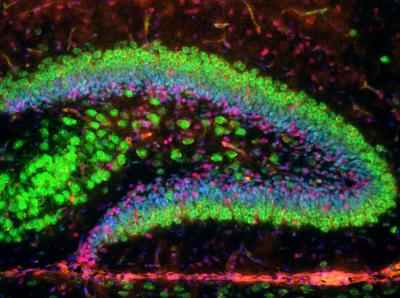New areas of the brain identified where ALS gene is active

The dentate gyrus of the mouse hippocampal formation which contributes to the formation of new episodic memories stained for neurons (green) and stem cells (red). Credit: Andrew L Bashford and Vasanta Subramanian University of Bath
For the first time novel expression sites in the brain have been identified for a gene which is associated with Motor Neuron Disease and Frontotemporal Dementia.
Many people who develop Motor Neuron Disease, also called Amyotropic Lateral Sclerosis (ALS), and/or Frontotemporal Dementia (FTD) have abnormal repeats of nucleotides within a gene called C9orf72 which causes neurons to die.
A team from the Department of Biology & Biochemistry at the University of Bath discovered for the first time that the C9orf72 gene is strongly expressed in the hippocampus of the mouse brain- a region where adult stem cells reside and which is known to be important for memory.
C9orf72 is also expressed at the olfactory bulb, involved in the sense of smell. Loss of smell is sometimes a symptom in FTD.
They also found that the C9orf72 protein changes from being concentrated in the cytoplasm of cells to both the cytoplasm and nucleus as the brain cortex develops, and during the development of neurons.
Dr Vasanta Subramanian, who led the study, said: “By uncovering novel sites of expression in the brain our findings provide an important resource for researchers studying animal models of C9orf72 mediated ALS and FTD.
“It is essential to know in which cell types in the nervous system the C9orf72 gene is expressed and where within the cell the C9orf72 protein is present.
“Our hope is that by researching accurate animal models of these diseases scientists can eventually develop new treatments and eventually cures for these devastating degenerative diseases.”
The researchers, Ross Ferguson, Eleni Serafeimidou- Pouliou and Vasanta Subramanian, were working to map expression of C9orf72 in developing and adult mouse brains to help characterise reliable animal models to study the gene and its effects in both kinds of neurodegenerative diseases, for which there are currently no cures.
Dr Brian Dickie, Director of Research Development at the Motor Neurone Disease Association, said: “It is unclear why people who carry an abnormality in genes like c9orf72 don't usually develop symptoms of these diseases until several decades after birth, but it is possible that the activity of the gene early in life somehow 'primes' certain types of neuron to degenerate later in life.
“This detailed study provides a platform for future research to understand the role of this important gene in health and disease.”
The exact function of C9orf72 in humans and animals remains unknown, but in the mutated version in patients there are large stretches of abnormal repeated sequences.
The study is published in the Journal of Anatomy.
The findings also confirmed previous research showing C9orf72 is strongly expressed in the cerebellum and motor cortex of the brain.
Media Contact
All latest news from the category: Life Sciences and Chemistry
Articles and reports from the Life Sciences and chemistry area deal with applied and basic research into modern biology, chemistry and human medicine.
Valuable information can be found on a range of life sciences fields including bacteriology, biochemistry, bionics, bioinformatics, biophysics, biotechnology, genetics, geobotany, human biology, marine biology, microbiology, molecular biology, cellular biology, zoology, bioinorganic chemistry, microchemistry and environmental chemistry.
Newest articles

High-energy-density aqueous battery based on halogen multi-electron transfer
Traditional non-aqueous lithium-ion batteries have a high energy density, but their safety is compromised due to the flammable organic electrolytes they utilize. Aqueous batteries use water as the solvent for…

First-ever combined heart pump and pig kidney transplant
…gives new hope to patient with terminal illness. Surgeons at NYU Langone Health performed the first-ever combined mechanical heart pump and gene-edited pig kidney transplant surgery in a 54-year-old woman…

Biophysics: Testing how well biomarkers work
LMU researchers have developed a method to determine how reliably target proteins can be labeled using super-resolution fluorescence microscopy. Modern microscopy techniques make it possible to examine the inner workings…





















